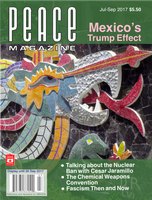
Peace Magazine July-September 2017, page 2. Some rights reserved.
The International Center for Tropical Agriculture (CIAT) and the International Fund for Agricultural Development (IFAD) have agreed to work together to boost resilience to climate change and improve the livelihoods of thousands of smallholder farmers globally. They intend to make new climate-smart technologies developed by CIAT research available to the smallholders in IFAD-supported projects in developing countries.
Two new projects will promote climate-smart agriculture in Central America and improve dairy production in East Africa through the use of improved, drought-resilient forage grasses.
Climate-smart farming reverses a current problem. Today about 30 percent of all greenhouse gas emissions are from agriculture. However, with climate-smart farming it is actually possible to produce “carbon-negative food“¯ meaning that the carbon content of the soil increases every year by removing it from the air and storing it in the earth.
Sources: UN and the Good News Service.
The thawing of the Arctic permafrost is releasing a potent greenhouse gas that has rarely been considered as a threat. Nitrous oxide, or N2O, is more of a threat than previously believed, according to Carolina Voigt, a researcher at the University of Eastern Finland.
Naturally occurring nitrous oxide, which is locked inside the frozen permafrost, is a potent greenhouse gas with 300 times the global warming potential of carbon dioxide.
Of all regions on Earth, the Arctic has seen some of the highest levels of warming. The region broke records for low sea ice levels and high temperatures last year, and continues to warm.
Scientists are studying some of the natural sources of carbon dioxide. The Arctic’s permafrost, which is steadily thawing as the region keeps getting warmer, is also releasing carbon dioxide into the atmosphere, creating a feedback loop of transformation that drives further warming.
Currently, the world’s largest source of terrestrial nitrous oxide is the tropical forest. However, emissions of nitrous oxide from permafrost peatlands with little vegetation cover could equal those from the tropics. A quarter of the Arctic’s land area is permafrost peatland.
“It’s definitely under-studied“¯ Voight said, “and it’s a large question mark, actually, in Arctic greenhouse gas research.”
Source:Scott Waldman, E&E News, Canadian Pugwash.
While Saudi Arabia seeks to isolate and punish its small neighbor, Qatar, for sponsoring terrorism, and while President Trump joins in blaming Qatar, the US has signed a deal to sell fighter jets to that country for $12 billion. In another ironic twist, both Qatar and Saudi Arabia have been involved in supporting terrorism.
Qatari Defence Minister Khalid bin Mohammed al-Attiyah met June 14 with US Defence Secretary Jim Mattis to sign the new purchase agreement for a number of F-15 fighter jets.
In the crisis between Qatar and the group of Arab nations led by the Saudis, all parties are US allies, which creates confusion inside Washington, Mattis has described Qatar as “moving in the right direction“¯ while Secretary of State Rex Tillerson continues asking all Arab Gulf nations to remain united. About 10,000 US troops are based in Qatar.
The Saudis have cut off the only land border to Qatar, making it necessary for the smaller country to import food from Turkey and Iran. Qatar’s friendly relations with Shi’ite Iran is one grievance that the Saudis are complaining about.
Source: Jon Gambrell, The Associated Press, June 15.
Scientists from Tel-Aviv University observed that Israeli farmers’ use of pesticides to kill rodents was also killing the rats’ natural bird predators and having a broader negative effect on biodiversity. They eventually convinced the government to eliminate the use of pesticides and instead to build boxes to attract owls and kestrels. The owls now consume thousands of rodents per year and increase control capacity by producing as many as 11 offspring per mating pair, every year.
Awareness then shifted to the existence of this as a regional rather than a national problem. Farmers in Palestine and Jordan also struggled with rodents. A “Birds Know No Boundaries” project began to attract attention from individuals in all three countries and many of these participants have become friends, across the borders. The success of the project in the Middle East was noticed in China and there is hope that a similar project might help build bridges between North and South Korea.
Source: Good News Network; goodnewsnetwork.org